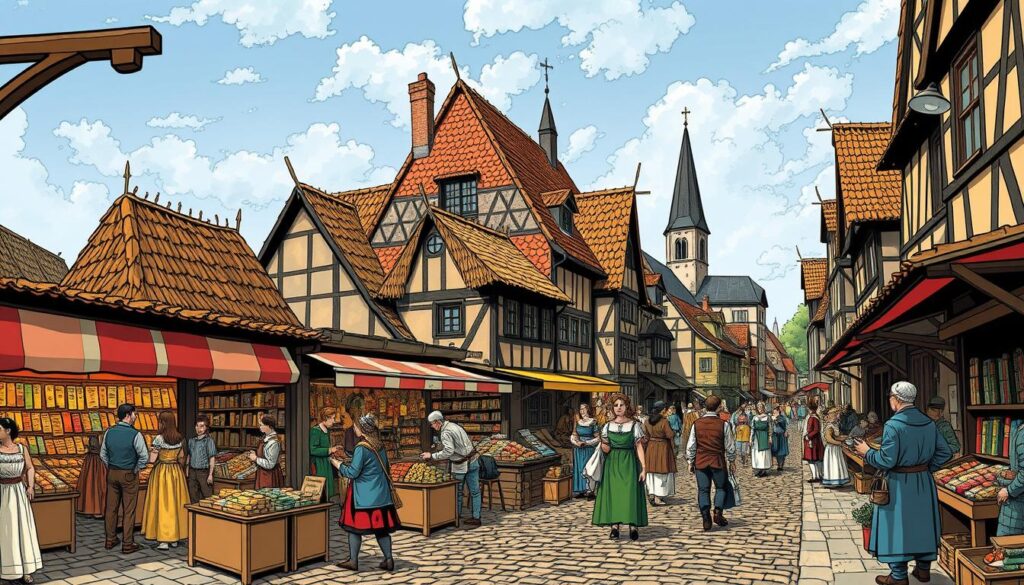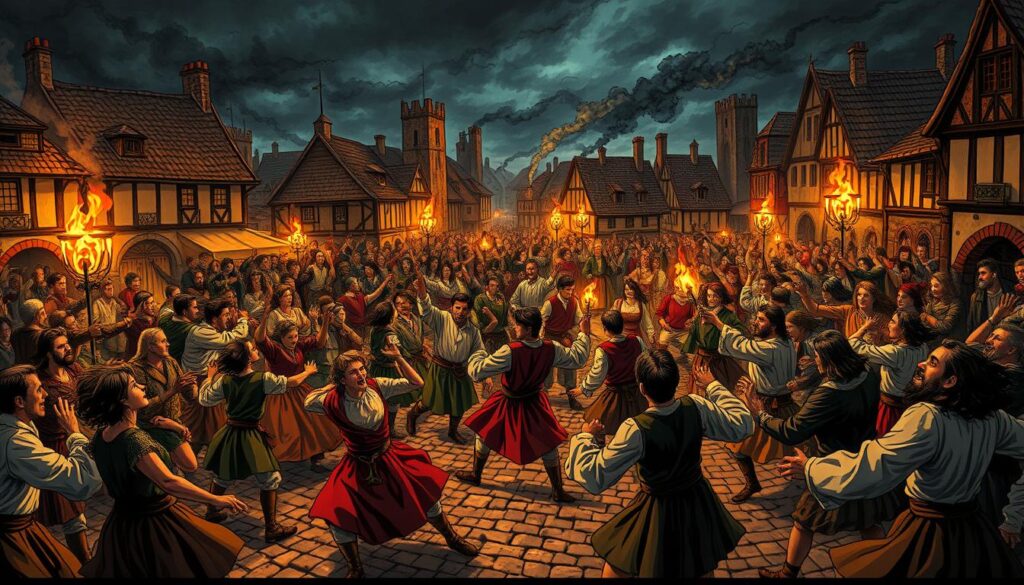The Dancing Plague of 1518: Uncontrollable Outbreak
In the summer of 1518, a strange event happened in Strasbourg. It was as if the city’s residents were caught in a spell. They couldn’t stop dancing, and it was contagious.
This wasn’t just a story. It was real, affecting many people. As I look into this event, I think about how quickly things can change. Joy can turn to madness, leaving people exhausted and sad.
The Dancing Plague of 1518 shows us how society can push us to extreme actions. It makes us wonder about the limits of human behavior.
Introduction to the Dancing Plague of 1518
The introduction to the Dancing Plague of 1518 is a shocking event in history. It started in Strasbourg during the summer of that year. A woman named Frau Troffea began dancing uncontrollably in the streets.
Her dance sparked a tragic chain reaction. Soon, dozens joined her, leading to the 1518 dancing mania.
This outbreak quickly grew. By August, records show that up to 400 people were dancing uncontrollably. They were in a trance-like state, unable to stop dancing.
Many collapsed from exhaustion, heat stroke, or heart attacks. This shows the severe impact of such unexplained behavior. It’s hard to imagine how dancing could lead to such tragic outcomes.
The phenomenon lasted for nearly two months. It shocked the local population with its intensity and scale. Authorities struggled to understand or manage the situation.
Many believed divine intervention or supernatural forces were behind it. To understand this, we must look at life in Alsace at the time. Many theories have emerged to explain this epidemic.

The Historical Context of 16th Century Europe
The 16th century in Europe was a time of great change and turmoil. It was a period when society faced many challenges. These challenges led to widespread emotional distress among people.
Europe was hit hard by famine, diseases, and superstition. These issues created an environment where strange events could happen. The chaos of daily life made things even worse, causing people to react in unusual ways.
Looking into the politics and society of that time, we see the “dancing plague” in Strasbourg was not alone. It was part of a larger picture of historical events and personal struggles. This makes it a compelling topic to explore further.

A Mysterious “Dancing Plague” Caused People to Dance Uncontrollably in 1518
In July 1518, a strange event started in Strasbourg, known as the dancing plague. It began with Frau Troffea, who couldn’t stop dancing. Her dance sparked a chain reaction, drawing over 400 people into this odd phenomenon.
For a month, the streets were filled with frantic dancing. People danced without control, pushing their bodies to the limit.
The dancing plague lasted for two months, causing severe exhaustion. Some victims had heart attacks or strokes from the intense dancing. Sadly, many people died from this strange frenzy.
Physicians thought more dancing could cure it, showing their confusion. This event remains a historical mystery.
Many theories try to explain the dancing plague. Some believe it was a curse from St. Vitus. Others think it might have been caused by ergot poisoning from bad rye bread. This event left a lasting mark on history, still puzzling people today.

How It All Started: The Beginning of the Outbreak
The dancing epidemic started in July 1518 with Frau Troffea. She danced wildly in Strasbourg’s streets. This caught everyone’s attention, sparking curiosity and wonder.
At first, people thought it was just a joyful moment. But soon, more and more joined Frau Troffea. About 400 people danced together, caught in a strange wave.
This chaos filled the community with fear and confusion. People wondered why it started and how it spread so fast. It makes me think about how quickly things can change in a crowd.
The Spread of the Dancing Epidemic in Strasbourg
The dancing epidemic in Strasbourg spread quickly and was very confusing. More and more people started dancing without reason, filling the city with chaos. I wanted to know how this happened in the community.
People talked about seeing others dance uncontrollably, caught in a frenzy. This left many very tired.
The dance mania didn’t just hit a few; it spread fast. Families, friends, and even strangers danced together. This strange dance brought people together, but also caused worry and confusion.
- Dance became a community activity, captivating those willing to partake.
- The exhaustion from relentless movement often led to dire consequences.
- Some participants experienced physical ailments, with reports of individuals fainting or worse.
During this time, the city’s reaction was mixed. Some people danced, while others watched in fear. They tried to understand this strange event. The dance mania showed us how people behave in strange times.
Authorities’ Responses to the Dance Mania
The dance mania in Strasbourg caught the local authorities off guard. At first, they thought more dancing was the answer. They built stages and hired musicians to encourage dancing.
But as more people got caught up in this strange compulsion, it became clear that wasn’t working. City officials had to rethink their strategy. They banned public dancing to try and stop the crisis.
This move showed how hard it was for officials to understand the dance mania. They were trying to keep order while figuring out what was happening.
Theories Behind the Bizarre Phenomena
The dancing plague is a mystery that fascinates many. People look at different theories to understand it. Each theory offers a possible explanation for this strange event.
Mass Hysteria as a Potential Cause
Some think mass hysteria was behind the dance mania. The stress and pressure in Strasbourg might have caused a psychological outbreak. This could have made more people join in the dancing.
Ergot Poisoning: The Fungus Theory
Another theory is ergot poisoning. It suggests a fungus in rye caused hallucinations and convulsions. This could explain the strange behaviors seen during the outbreak.
Religious and Superstitious Influences
Religion also played a role in the mystery. Many believed they were cursed by St. Vitus and danced to atone. Superstitions and faith were deeply connected, adding to the complexity of the situation.
Documented Cases of Unexplained Behavior
The Dancing Plague of 1518 in Strasbourg is full of documented cases of strange behavior. People were seen dancing uncontrollably, often until they were too tired to move. These stories give us a peek into the emotional and social world of that time.
Looking into historical accounts, I find it interesting to see what people saw back then. Dancers filled public squares and alleys, causing a stir. People watching were both curious and worried, showing how serious this was for everyone.
History is full of mass hysterical behaviors that show us how complex human psychology is. Events like the St. John’s Dance in the 14th century show us patterns of group behavior we still don’t get. Exploring these events makes me wonder more about why such things happen.
Interpreting Historical Reports on the Dancing Mania
Looking into the dancing plague of 1518, historical reports are key. They help us understand how people saw this strange event. These documents show us the thoughts of the people in Strasbourg during a hard time.
They tell us about the dancers’ symptoms and how society and religion reacted. This gives us a glimpse into the era’s mindset.
When we look at the interpretation of events from 1518, we see biases. Many believed it was caused by demons or divine wrath. These views show what people feared and believed back then.
Reports also show the community’s struggles with famine, disease, and superstition. This adds depth to our understanding of the outbreak. Some reports talk about people collapsing and others about authorities trying to stop the chaos.
By diving into these historical reports, we gain a better understanding of the dancing mania. We see how psychological, social, and cultural factors played a role. Reflecting on these stories helps us see their lasting impact on how we view group behavior.
The Impact of the Dancing Plague on Strasbourg’s Society
The Dancing Plague of 1518 changed Strasbourg’s society in big ways. It caused chaos in daily life, making people interact differently. This changed how they saw their community and each other.
Social structures were shaken by the mass hysteria. People questioned who was in charge. They looked to leaders for answers but often felt let down. This uncertainty led to social unrest.
The event also made people rethink their beliefs. Many believed it was caused by religion or the supernatural. This made the community question faith, fear, and health. It changed how they saw illness and divine intervention.
- Altered perceptions of authority: Trust in local governance weakened.
- New understandings of health: Discussions about illness began to include more psychological aspects.
- Changes in religious beliefs: Some saw the epidemic as a warning or punishment.
Looking back, we see how the Dancing Plague affected society. It shows how big events can change how we remember and think about the past.
Modern Relevance and Fascination with the Dance Epidemic
The Dancing Plague of 1518 still fascinates me. It’s a historical event that draws attention from historians and psychologists. Nearly 400 people in Strasbourg danced uncontrollably, raising questions about human behavior today.
Understanding mass psychogenic illness is key to the dancing epidemic. Similar events, like the laughing epidemic in Tanzania in the 1960s, have happened before. These events show how stress can affect communities, just like the dancing plague.
Thinking about the dancing plague’s causes makes me curious. Some believe ergot poisoning or the social climate of 16th-century Europe played a role. It shows how history can teach us about our behavior today.
In today’s world, we see mass psychogenic illness in schools and workplaces. These events, like the dancing plague, make me think about how our emotions and surroundings affect us. Looking back at this event helps us understand the link between society and human behavior.
Lessons from Historical Events: Understanding Human Behavior
The Dancing Plague of 1518 teaches us a lot about human behavior under stress. In Strasbourg, many people danced for days without stopping. This shows how big pressures from society can change how we act.
This event shows how our minds and social groups interact. It caused a big mess that went beyond just a few people. It also made a mark on the culture of Strasbourg, seen in art like “Danse Macabre.”
This event makes me think about today’s world. With stress all around us, it’s key to learn from the past. Looking at history helps us understand our own behaviors and how we react together.







